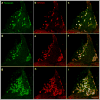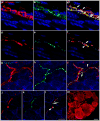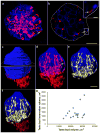The transcription factor Phox2b distinguishes between oral and non-oral sensory neurons in the geniculate ganglion
- PMID: 28856690
- PMCID: PMC5912919
- DOI: 10.1002/cne.24312
The transcription factor Phox2b distinguishes between oral and non-oral sensory neurons in the geniculate ganglion
Abstract
Many basic characteristics of gustatory neurons remain unknown, partly due to the absence of specific markers. Some neurons in the geniculate ganglion project to taste regions in the oral cavity, whereas others innervate the outer ear. We hypothesized that the transcription factor Phox2b would identify oral cavity-projecting neurons in the geniculate ganglion. To test this possibility, we characterized mice in which Phox2b-Cre mediated gene recombination labeled neurons with tdTomato. Nerve labeling revealed that all taste neurons projecting through the chorda tympani (27%) and greater superficial petrosal nerves (15%) expressed Phox2b during development, whereas non-oral somatosensory neurons (58%) in the geniculate ganglion did not. We found tdTomato-positive innervation within all taste buds. Most (57%) of the fungiform papillae had labeled innervation only in taste buds, whereas 43% of the fungiform papillae also had additional labeled innervation to the papilla epithelium. Chorda tympani nerve transection eliminated all labeled innervation to taste buds, but most of the additional innervation in the fungiform papillae remained. Some of these additional fibers also expressed tyrosine hydroxylase, suggesting a sympathetic origin. Consistent with this, both sympathetic and parasympathetic fibers innervating blood vessels and salivary glands contained tdTomato labeling. Phox2b-tdTomato labels nerve fascicles in the tongue of the developing embryo and demonstrates a similar stereotyped branching pattern DiI-labeling.
Keywords: Phox2b; RRID: AB_2314683; RRID: AB_531826; RRID: AB_632496; RRID: IMSR_JAX:007914; RRID: MMRRC_034613-UCD; geniculate ganglion; taste; taste bud; taste bud innervation.
© 2017 Wiley Periodicals, Inc.
Figures









Similar articles
-
TrkB expression and dependence divides gustatory neurons into three subpopulations.Neural Dev. 2019 Jan 28;14(1):3. doi: 10.1186/s13064-019-0127-z. Neural Dev. 2019. PMID: 30691513 Free PMC article.
-
Cell non-autonomous requirement of p75 in the development of geniculate oral sensory neurons.Sci Rep. 2020 Dec 17;10(1):22117. doi: 10.1038/s41598-020-78816-y. Sci Rep. 2020. PMID: 33335119 Free PMC article.
-
Organization of geniculate and trigeminal ganglion cells innervating single fungiform taste papillae: a study with tetramethylrhodamine dextran amine labeling.Neuroscience. 1999;93(3):931-41. doi: 10.1016/s0306-4522(99)00115-3. Neuroscience. 1999. PMID: 10473258
-
Hedgehog Signaling Regulates Taste Organs and Oral Sensation: Distinctive Roles in the Epithelium, Stroma, and Innervation.Int J Mol Sci. 2019 Mar 16;20(6):1341. doi: 10.3390/ijms20061341. Int J Mol Sci. 2019. PMID: 30884865 Free PMC article. Review.
-
Building sensory receptors on the tongue.J Neurocytol. 2004 Dec;33(6):631-46. doi: 10.1007/s11068-005-3332-0. Epub 2005 Oct 11. J Neurocytol. 2004. PMID: 16217619 Review.
Cited by
-
Onset of taste bud cell renewal starts at birth and coincides with a shift in SHH function.Elife. 2021 May 19;10:e64013. doi: 10.7554/eLife.64013. Elife. 2021. PMID: 34009125 Free PMC article.
-
TrkB expression and dependence divides gustatory neurons into three subpopulations.Neural Dev. 2019 Jan 28;14(1):3. doi: 10.1186/s13064-019-0127-z. Neural Dev. 2019. PMID: 30691513 Free PMC article.
-
Oral Sensory Neurons of the Geniculate Ganglion That Express Tyrosine Hydroxylase Comprise a Subpopulation That Contacts Type II and Type III Taste Bud Cells.eNeuro. 2022 Oct 13;9(5):ENEURO.0523-21.2022. doi: 10.1523/ENEURO.0523-21.2022. Print 2022 Sep-Oct. eNeuro. 2022. PMID: 36216506 Free PMC article.
-
Prdm12 represses the expression of the visceral neuron determinants Phox2a/b in developing somatosensory ganglia.iScience. 2023 Oct 31;26(12):108364. doi: 10.1016/j.isci.2023.108364. eCollection 2023 Dec 15. iScience. 2023. PMID: 38025786 Free PMC article.
-
Cyclophosphamide induces the loss of taste bud innervation in mice.Chem Senses. 2024 Jan 1;49:bjae010. doi: 10.1093/chemse/bjae010. Chem Senses. 2024. PMID: 38421250 Free PMC article.
References
-
- Baker CV, Bronner-Fraser M. Vertebrate cranial placodes I. Embryonic induction. Developmental Biology. 2001;232(1):1–61. https://doi.org/10.1006/dbio.2001.0156. - DOI - PubMed
-
- Castillo D, Seidel K, Salcedo E, Ahn C, de Sauvage FJ, Klein OD, Barlow LA. Induction of ectopic taste buds by SHH reveals the competency and plasticity of adult lingual epithelium. Development. 2014;141(15):2993–3002. https://doi.org/10.1242/dev.107631. - DOI - PMC - PubMed
-
- Chaudhari N, Roper SD. The cell biology of taste. The Journal of Cell Biology. 2010;190(3):285–296. https://doi.org/10.1083/jcb.201003144. - DOI - PMC - PubMed
-
- Coggeshall RE, La Forte R, Klein CM. Calibration of methods for determining numbers of dorsal root ganglion cells. Journal of Neuroscience Methods. 1990;35(3):187–194. - PubMed
-
- Coppola E, Rallu M, Richard J, Dufour S, Riethmacher D, Guillemot F, … Brunet JF. Epibranchial ganglia orchestrate the development of the cranial neurogenic crest. Proceedings of the National Academy of Sciences of the United States of America. 2010;107(5):2066–2071. https://doi.org/10.1073/pnas.0910213107. - DOI - PMC - PubMed
MeSH terms
Substances
Grants and funding
LinkOut - more resources
Full Text Sources
Other Literature Sources
Molecular Biology Databases

